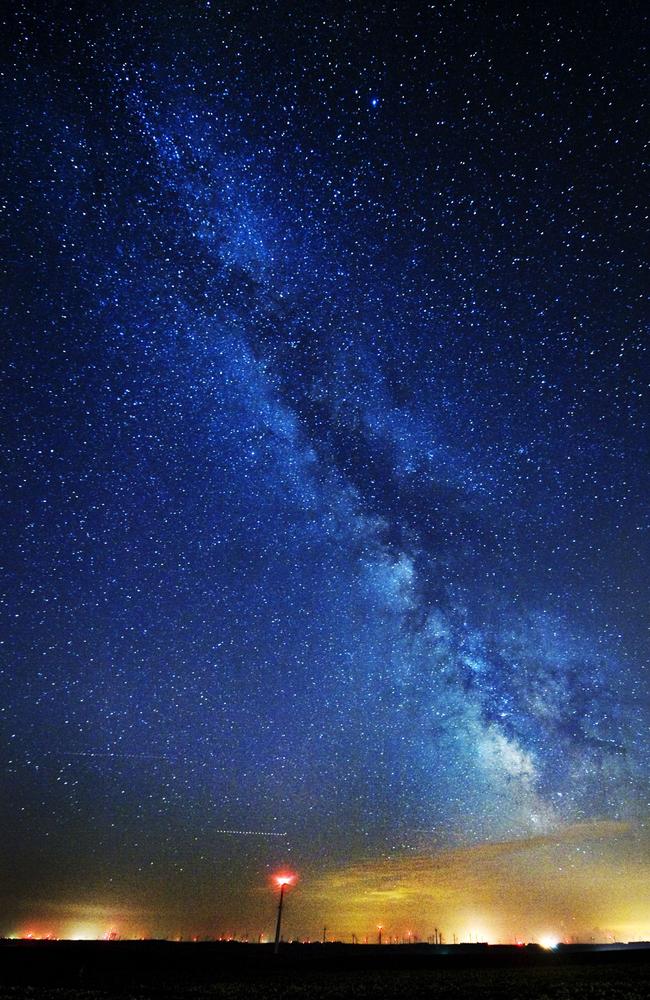EVERY 30 million years, Earth goes through a seemingly scheduled die-off. A new idea has been put forward to explain it: Elusive, mysterious dark matter.
New York University Biology Professor Michael Rampino believes so.

In a new paper published in the Monthly Notices of the Royal Astronomical Society, he postulates that the near-clockwork “plunge” of our solar system through our crowded spiral arm as it makes its 250 million-year orbit of the Milky Way galaxy.
The professor’s argument is that our solar system — and the Earth — regularly dips through a cloud of subatomic particles which wreaks havoc on the stability of our planet’s molten core and the fragile orbits of comets.
RELATED: Are four lost stars trapped in a dark matter cloud?
These subatomic particles, he says, are of ever elusive dark matter — the so far invisible, and unproven, substance that appears to make up most of the substance of the universe.
“The history of the Earth is punctuated by large scale extinction events, some of which we struggle to explain,” Professor Rampino says. “ It may be that dark matter — the nature of which is still unclear but which makes up around a quarter of the universe — holds the answer. As well as being important on the largest scales, dark matter may have a direct influence on life on Earth.”

Being invisible, we’ve not found any yet.
Physicists have inferred it is there: Most recently, an invisible cloud of dark matter has been put forward as the gravitational influence holding an almost impossible cluster of four stars together in deep space near our own galaxy.
RELATED: 14 ‘Death Stars’ are headed our way
Linking it to Earth-shattering events in our planet’s past? Astrophysicist Dr Michael Brown of Monash University doesn’t think so.
“It just doesn’t add up,” he says.

CATACLYSMIC CORRELATION
The spiral arm of the Milky Way in which our solar system resides is a busy place. It’s full of stars, dust and gas clouds — and unseen wafts of dark matter.
It’s the stuff that binds the galaxy together.
Professor Rampino links the timescale of these dips through the galactic plane to that of Earth-shaking natural disasters — such as the comet impact which is believed to have killed off the dinosaurs 66 million years ago.
He speculates concentrated dark matter clouds could cause comet orbits to become unstable.
Dr Brown says this simply doesn’t seem possible.
“Claims of periodicity of extinctions is still viewed sceptically, and connecting these to the passage of the Solar System through the galaxy is simply shaky,” he says. “It is really dubious connecting this all to dark matter.”
While wandering stars are known to periodically pass through the enormously distant Oort cloud which surrounds our solar system, even these gravitationally intense objects may only topple a few comets towards a million-year spiral down to our Sun and inner planets.
“Dark matter’s not as concentrated as conventional matter,” Dr Brown says. “Matter can collapse and form stars. Dark matter is a diffuse cloud which the galaxy sits within. It’s not particularly concentrated, so it’s hard to imagine it making this sort of regular surge of activity in our solar system.”
DEATH FROM ABOVE: Will supernova Eta Carinae kill us all?
Dark matter, by its very nature, appears to be very “light and fluffy”: The very attributes which make it so difficult to detect.
“Such a really strong concentration of dark matter needed to create a surge in gravitational force is really unlikely,” Dr Brown says.
If it did happen, the dark-matter cloud would produce rippling effects we could observe on other stars about us. So far, we haven’t.
GALACTIC PRESSURE-COOKER
Professor Rampino’s claims don’t end with wayward comets: He believes each pass through a dark matter cloud can cause a build-up of the mysterious material within the Earth’s core.
Eventually, he says, these dark matter particles annihilate each other. This produces heat.
With the Earth’s core becoming increasingly unstable as a result, it could trigger “volcanic eruptions, mountain building, magnetic field reversals, and changes in sea level, which also show peaks every 30 million years” a Royal Astronomical Society statement reads.
At least, that’s the idea.
But such disasters are a dark matter of another kind: There are many different, and interlinked, potential causes.

Dr Brown says invisible gravitationally-active particles would be pretty much at the bottom of this list.
“Dark matter doesn’t interact much with anything,” he says. “ It can pass through the Earth and the Sun without any effect whatsoever. It’s what makes it dark. To have it producing a reaction in the centre of the Earth such that it influences the planet is really, really shaky.”
If dark matter could produce such an effect, we’d be able to detect it.
“The claimed connection of dark matter to geological activity is sailing close to nonsense,” he says.


Add your comment to this story
To join the conversation, please log in. Don't have an account? Register
Join the conversation, you are commenting as Logout
Here’s what you can expect with tomorrow’s Parramatta weather
As we move into summer what can locals expect tomorrow? We have the latest word from the Weather Bureau.
Here’s what you can expect with tomorrow’s Parramatta weather
As we move into summer what can locals expect tomorrow? We have the latest word from the Weather Bureau.